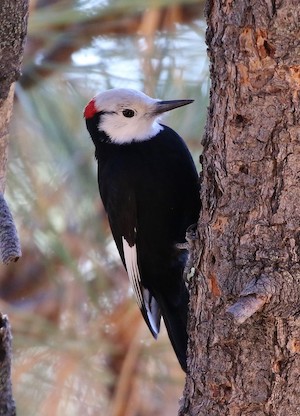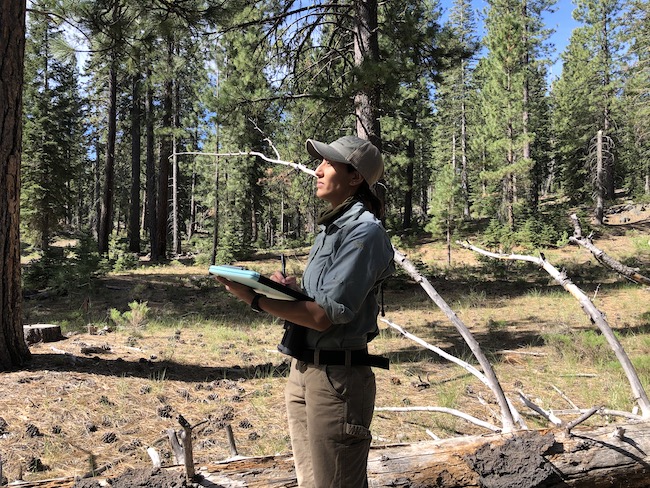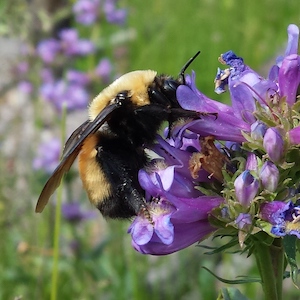
White-headed Woodpecker. Photo by Tom Benson/Flickr.jpg
The ponderosa pine forests of the western US are something special. On a summer day, the sun-warmed trunks of large ponderosas exude a vanilla or butterscotch aroma. Because their branches begin higher on their trunk than firs or spruces, ponderosa forests feel open and are easy to walk through. Light penetrates the canopy, supporting wildflowers, grasses and shrubs on the forest floor. These forests are just as inviting to wildlife as they are to humans. They provide valuable habitat for birds like Northern Goshawks, White-headed Woodpeckers, Red Crossbills and more.
But while ponderosas are the most widely distributed pine species in North America, ponderosa pine forests have changed dramatically in the modern era due to timber harvest and fire suppression. Large ponderosa pines produce desirable lumber and so were preferentially harvested. Fire suppression did not help them either. Ponderosas are fire-adapted and trees over the age of 5 years have thick bark that protects them from low intensity fires. In the past, frequent fires helped maintain open ponderosa pine forests by reducing the density of young trees and competition from fire-sensitive tree species like white fir. These factors have changed the structure of many ponderosa forests and the wildlife habitat that they provide.
Foresters and conservationists wanted to figure out how to bring back the historic ponderosa pine ecosystem- or at least get as close to it as possible. So in the late 1990s, the US Forest Service started a long-term experiment in the Klamath National Forest in northern California. The experiment divided the Goosenest Adaptive Management Area into 20 plots of 100 acres each. Between 1998-2001, each plot was subjected to one of four forestry treatments: thinning smaller trees regardless of species and prioritizing tree spacing, retaining ponderosas but thinning other conifer species, thinning other conifers and also incorporating prescribed fire, and control (no thinning or fire treatments.)

Views of the forest plots in 2021, 20+ years after treatment: a control plot (no treatment) is pictured on the left, a treatment plot with thinning of trees other than ponderosa pine and prescribed fire is on the right. Photos courtesy of Alma Schrage.
Now, two decades later, foresters are carefully evaluating how the trees and forest structure responded to the forestry treatments, but the experiment also aimed to evaluate the treatments’ effect on wildlife. In 1996, prior to the forestry treatments, and in 2002 and 2003, shortly after the treatments, bird populations in the Goosenest Adaptive Management Area were carefully surveyed by IBP research associate Dr. Luke George and colleagues. This summer IBP biologists are conducting longer-range “after” surveys to determine how these forestry treatments affected not only bird populations, but pollinators as well, over a period of decades rather than years.
Birds have long been used as ecological indicators because they are relatively high on the food chain, mobile (they can go elsewhere if the habitat is poor quality) and conspicuous (they are relatively easy to survey). But pollinators are an important part of the ecosystem as well and they are directly affected by changes in vegetation that affect flower availability. Our pollinator surveys are focused on bumble bees and butterflies, as these groups contain species of concern and are more easily identified to species in the field than many other insect pollinators.

A two-banded checkered skipper. Photo by John Gorey.
The bird surveys wrapped up for the season last week. Results have not been analyzed yet, but bird survey crew member Christina Varian says that more open, treated plots seemed to be hotspots for birds. “Control plots seem to have overall fewer birds and lower diversity compared to more open plots, like ponderosa pine retention with fire treatment, where it’s just a cacophony of diverse songs,” she says. “I imagine it as a giant bird party, where everyone is invited.” The bird crew was lucky enough to spot a Northern Goshawk as well as a few unexpected finds such as Orange-crowned Warbler and an abundance of Warbling Vireos.
The pollinator crew is still at work as many bumble bee and butterfly species become more active later in the summer. “As the season has progressed it seems like every week we go out we see new butterfly and bee species,” says John Gorey of the pollinator crew. “So for the time being, diversity and abundance are increasing on an almost exponential scale.” Again, data are still being collected so we only have first impressions, but it appears that the denser control sites (no thinning or fire treatment) are not favored by the bumble bees and butterflies. “They are covered in dense trees with little to no flowering plants. We rarely see much on these sites but occasionally we see a Great Arctic flitting around in a sunny pocket,” says Gorey.

A Fernald's cuckoo bumble bee. Photo by Matt Muir/iNaturalist.
Some fun pollinator finds so far have been two-banded checkered skipper(Pyrgus ruralis ) and Sierra Nevada blue (Agriades podarce) butterflies, as well as Fernald's cuckoo bumble bee (Bombus fernaldae.) This species parasitizes broods of other bumble bee species, much like Brown-headed Cowbirds parasitize broods of other bird species. There are 28 species of brood parasitic or cuckoo bumble bees in the world, and they are largely under-studied and thought to be more vulnerable to extinction than non-parasitic bumble bees.
Public and private land managers across California and the American West are racing to treat forests with selective logging and prescribed fire, not just to restore desired conditions for wildlife in ponderosa forests, but more urgently to reduce the risk of large, stand-replacing wildfire. Our work at Goosenest Adaptive Management Area will help ensure that these efforts take into account the habitat needs of wildlife like birds, bees, and butterflies.






